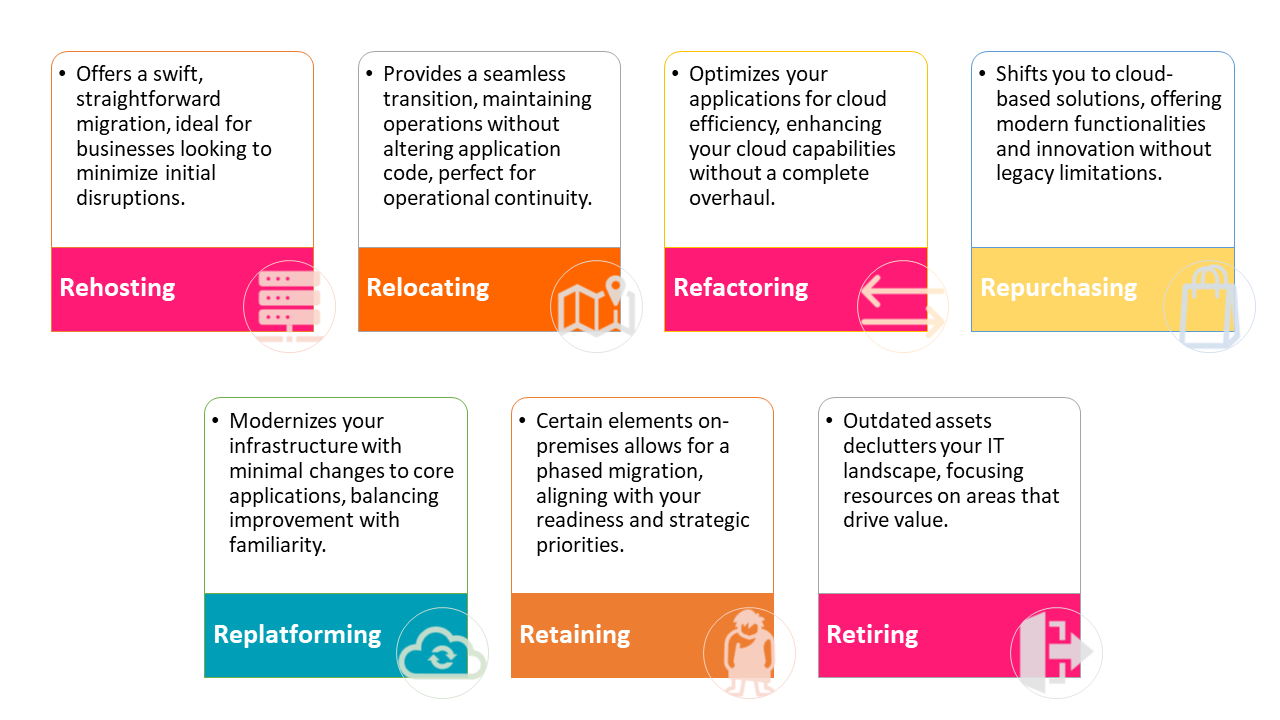Escape the Dinosaur Age: A Comprehensive Blueprint for Cloud Migration Mastery
Are you watching competitors speed ahead while your business chugs along with outdated technology? If so, it might be time to leave the dinosaur age behind and unlock the power of cloud migration.

Table of Content
Essential Secrets for Cloud Migration Success
Laying the Groundwork: The Imperative of Strategic Cloud Migration
The Human Aspect: Cultivating a Cloud-Ready Organisation
Navigating the Migration Path: Technical Excellence and Security
Beyond the Cloud Horizon: Sustained Growth and Innovation
Solidifying Success Through Strategic Partnerships
Launching Your Cloud Migration Voyage
Essential Secrets for Cloud Migration Success
Are you weary of feeling as though your business is mired in the digital equivalent of the Stone Age, shackled by archaic systems and processes? You are not alone. numerous organisations recognise that it's time for a significant shift, and cloud migration is essential for modernising enterprises.
But what does the transition to a public cloud environment entail, exactly, and how can you ensure this journey profoundly transforms your operations for the better, rather than leading you into unknown territory?
Cloud migration is much more than simply upgrading technology. It represents a strategic leap towards scalability, agility, and innovation.
Nonetheless, navigating through this transformative journey necessitates a robust cloud migration strategy. Such a strategy must be customised to your distinct business needs and ambitions to guarantee a seamless transition and drive your business forward in the competitive arena.
In this detailed guide, titled "Escape the Dinosaur Age: A Comprehensive Blueprint for Cloud Migration Mastery," we delve into the complexities of cloud migration. Drawing upon a wealth of experience in transferring complex workloads to the cloud, this article distils the essence of numerous projects into practical insights.
We'll examine how to develop a cloud migration strategy to transfer workloads such as data, virtual machines, and applications to the cloud environment and align them with your overarching business objectives.
Laying the Groundwork: The Imperative of Strategic Cloud Migration
Before diving into the depths of cloud migration, laying a solid foundation is essential. Choosing the right cloud providers, understanding the variety of cloud environments, and selecting appropriate cloud resources are crucial steps that underpin the entire migration process.
This groundwork ensures that your migration strategy is not just about moving to the cloud but about moving to the right cloud setup for your specific needs.
The cloud migration Several key factors drive the cloud migration imperative and Scalability: The cloud offers a flexible pay-as-you-go model, allowing businesses to adjust resources based on demand, thus optimising costs and ensuring scalability.
- Agility and Innovation: Cloud environments enable rapid deployment of applications and services, fostering an innovative and responsive business model.
- Disaster Recovery and Continuity: Robust cloud platforms enhance disaster recovery capabilities, ensuring business operations can quickly resume after unforeseen events.
- Access to Advanced Tech: Migrating to the cloud opens up opportunities to integrate cutting-edge technologies like AI and IoT into your operations, without the need for heavy investment in infrastructure.
- Security and Compliance: Leading cloud providers invest in top-tier security measures and comply with various regulatory standards, offering businesses a secure and compliant infrastructure.
Whether considering a full transition to a public cloud, private cloud and/or hybrid cloud model or looking to enhance your existing setup, strategic benefits such as scalability, cost-efficiency, security, and innovation become pivotal.
Crafting Your Cloud Migration Blueprint
Crafting your blueprint is akin to drawing a detailed map before embarking on a treacherous journey. It's about meticulous planning and precision in execution, ensuring every step of the migration process is carefully thought out and strategically aligned with your business objectives.
Furthermore, a successful migration isn't just about the technology; it's equally about your team. Investing in their skills and fostering an environment that embraces change and transformation is the true cornerstone of successful migration.
The blueprint should encompass:
- In-Depth Planning: Assess current IT infrastructure to identify cloud-ready components and those needing updates.
- Selecting Cloud Providers: Choose providers that align with your growth vision and offer necessary services.
- Team Investment: Develop team skills and foster a culture of change for a smooth migration.
- Holistic Approach: View migration as an opportunity for organisational transformation, not just data transfer.
Additionally, the blueprint should cover:
- Risk and Compliance: Identify industry-specific risks and compliance requirements for a secure cloud setup.
- Data Governance: Plan for data privacy and security, crucial in multi-cloud or hybrid environments.
- Application Prioritization: Decide which applications to migrate first based on complexity and business impact.
- Cost Management: Establish cost monitoring and optimisation to prevent unexpected expenses.
- Change Management: Outline strategies for managing organisational change, including communication and training.
So, your cloud migration blueprint is a strategic roadmap ensuring a seamless transition aligned with your business goals. It meticulously guides every step, from infrastructure assessment to change management, setting the stage for innovation and growth.
The Human Aspect: Cultivating a Cloud-Ready Organisation
Evaluating Your Cloud Readiness
Before diving headfirst into this transformation, it's imperative to assess your organisation's readiness for such a shift. This involves a thorough evaluation of your current infrastructure, workflows, and most importantly, the willingness and ability of your team to adapt to new cloud-based environments.
To support the "The Human Aspect: Cultivating a Cloud-Ready Organisation" section, key points include:
- Infrastructure and Workflow Assessment: Evaluate existing IT infrastructure and workflows to identify potential adjustments needed for cloud integration.
- Team Willingness and Adaptability: Assess the team's openness to change and their ability to adapt to cloud technologies, which is crucial for a smooth transition.
- Skill Alignment and Training: Align cloud resources with your team's current skills and identify areas where training is needed to enhance cloud proficiency.
- Change Management Strategies: Develop strategies to manage the organisational change that accompanies cloud migration, including clear communication, support structures, and incentives for adoption.
- Setting Clear Objectives: Establish specific, measurable goals for what the cloud migration aims to achieve, helping to focus efforts and measure progress.
- Performance Metrics: Define clear metrics to evaluate the success of the cloud migration and the ongoing performance of cloud-based operations.
- Compliance and Security: Ensure the migration plan addresses compliance requirements and security protocols to protect data and operations in the cloud environment.
Addressing these points ensures a comprehensive evaluation of your organisation's cloud readiness and sets a solid foundation for a successful migration, focusing on both the technical and human aspects of the transition.
Setting Clear Objectives and Metrics
In public clouds, delineating clear objectives and metrics is crucial for a seamless transition from on-premises data centres to cloud environments. Effective cloud cost management is pivotal, ensuring economic viability and strategic alignment with your business strategy.
Incorporating principles of Cloud FinOps into your planning can also ensure financial accountability and optimisation of cloud resources, effectively transforming cloud cost management from a mere operational concern to a strategic advantage.
- Defining Tangible Goals: Establish specific, achievable objectives for what the aims to accomplish, such as increased agility, scalability, or market responsiveness.
- Key Performance Indicators (KPIs): Identify clear KPIs that will measure the success of the migration, including operational efficiency, cost savings, and performance benchmarks.
- Cloud Cost Management: Integrate cloud cost considerations into the migration strategy to ensure economic viability and strategic alignment with business goals.
- Cloud FinOps Principles: Apply Cloud Financial Operations (FinOps) principles to ensure financial accountability and optimise cloud resource usage, turning operational costs into strategic investments.
- Organisational Alignment: Foster collaboration and alignment among all stakeholders to ensure a unified approach to leveraging cloud capabilities and achieving common objectives.
- Strategic Exit Planning: Develop a well-coordinated plan for transitioning from on-premises infrastructure to the cloud, minimizing disruptions and ensuring continuity.
- Sustainable Growth: Focus on optimizing cloud costs to support sustainable business growth, ensuring that cloud investments contribute to long-term success.
Embracing these principles solidifies your migration blueprint, ensuring a strategic, cost-effective, and cohesive journey to the cloud.
Navigating the Migration Path: Technical Excellence and Security
Navigating the path to the cloud demands not just a robust migration strategy but also an unwavering commitment to technical excellence and security. As you delve into this crucial phase, it's imperative to bear in mind the diverse landscape of cloud solutions and the intricate security and compliance requirements that govern them. This section will guide you through the process of making informed choices that align with your specific needs and goals.
Technology and security are vital in ensuring that your cloud journey enhances your technical capabilities and fortifies your defences, making your cloud platforms and services robust, secure and resilient.
Technical Excellence:
- Customised Migration Approach: Tailoring your migration strategy to your organisation's specific technical and operational landscape is crucial for seamless integration and performance optimisation.
- Advanced Technical Capabilities: Leveraging cutting-edge cloud technologies to enhance your infrastructure's efficiency, scalability, and innovation potential is key to maintaining a competitive edge.
- Continuous Optimisation: Implementing continuous improvement practices for your infrastructure is vital to adapt to changing technical demands and optimise cost and performance.
Security: Security and compliance are crucial for a successful cloud migration. Focusing on these areas ensures your move not only meets standards but also strengthens your defence against new threats.
- Rigorous Compliance Adherence: Ensuring your cloud migration and operations comply with relevant industry regulations and security standards is critical to protect your organisation from legal and reputational risks.
- Robust Data Protection: Prioritizing the security of sensitive data through encryption, access controls, and secure data transfer mechanisms is essential to maintain trust and integrity.
- Proactive Threat Management: Establishing advanced security measures and threat detection systems to quickly identify and mitigate potential risks is crucial for safeguarding your cloud environment.
This approach allows you to leverage the strengths of the cloud while mitigating risks (especially with legacy infrastructure, data centre exit etc/) and ensuring that your cloud computing resources like virtual machines, physical servers, platform services, business intelligence etc. are both robust and adaptable.
Tailoring Your Migration Strategy to Your Unique Landscape
Developing a cloud migration strategy tailored to your business needs is essential yet challenging. This process requires a deep understanding of available cloud migration strategies and how they can be tailored to your requirements.
Here are the key areas of consideration
- Understand Migration Types: Grasp the various migration approaches (rehost, replatform, rearchitect, etc.) and determine which best aligns with your specific requirements, considering the nature of your applications and workloads.
- Application and Workload Analysis: Conduct a detailed analysis of your existing applications and workloads to understand their performance in the cloud and identify the most suitable cloud models (public, private, hybrid, multi-cloud) for each.
- Business and Operational Alignment: Ensure your migration strategy is not just technically sound but also aligns with your business goals, and operational capabilities, and enhances overall performance.
- Security and Compliance: Prioritize rigorous security measures and compliance with relevant standards as a core component of your migration strategy, especially for handling sensitive data and critical applications.
- Provider and Technology Fit: Choose cloud providers and technologies that offer the best fit for your specific needs, taking into account their capabilities, services, and compatibility with your existing infrastructure.
Incorporating these considerations will help develop a migration strategy that is customised to your organisation's unique landscape, ensuring a successful and secure transition to the cloud.
Attention to Legacy and other compliance needs
In this assessment, focus on the challenges of migrating on-prem applications and managing sensitive data. Legacy systems, with their intricate designs and integral business roles, may require extensive reengineering for cloud compatibility, posing significant migration obstacles. Likewise, compliance with data protection regulations in the cloud demands careful planning. A thorough approach ensures a smooth cloud transition, maximizing benefits and minimizing risks to operations.
- Complex Architectures: Legacy systems often have intricate architectures that are deeply integrated into business operations, making them difficult to migrate without substantial modifications or reengineering.
- Integration Issues: Legacy applications may face compatibility issues with modern cloud services and platforms, requiring additional efforts for integration.
- Data Migration Concerns: Transferring data from legacy systems to the cloud can be challenging due to the potential for data loss or corruption during the migration process.
- Performance Risks: There's a risk that legacy applications might not perform optimally in a cloud environment without significant adjustments, potentially affecting business operations.
Cloud Compliance Issues:
- Data Protection Laws: Compliance with data protection regulations (like GDPR) is crucial when migrating data to the cloud, necessitating stringent data handling and privacy measures.
- Industry-Specific Regulations: Certain industries are subject to specific regulatory standards that must be adhered to when moving operations to the cloud, adding complexity to the migration process.
- Cross-Border Data Transfers: The transfer of data across geographical borders in the cloud can introduce compliance challenges due to varying international laws and regulations.
- Access Controls and Audit Trails: Ensuring proper access controls and maintaining audit trails for data and applications in the cloud are essential for compliance and security.
Tailoring the 7 R's of cloud migration
Tailoring the 7 R's of cloud migration to your unique needs is an essential aspect of crafting a strategic approach with your chosen cloud provider. This nuanced strategy encompasses a spectrum from simply moving data and applications to a cloud computing environment, to more complex transformations that may involve a hybrid cloud setup or rethinking the role of your data centre entirely."

Navigating these options allows for a customised data migration plan that aligns with your business objectives, operational needs, and long-term vision for leveraging cloud technologies.
Beyond the Cloud Horizon: Sustained Growth and Innovation
Implementing Effective Cloud Governance
Transitioning beyond the initial phase of cloud migration, "Implementing Effective Cloud Governance" is pivotal in steering organisations towards sustainable growth and fostering a culture of continuous innovation within the cloud framework. This segment marks the inception of an enduring transformation, emphasizing the importance of not just establishing but meticulously managing and refining the cloud solution to secure long-term organisational prosperity.
Key strategies include:
- Develop clear governance protocols for cloud alignment with business goals and compliance.
- Implement strict access controls to protect cloud resources and data integrity.
- Continuously monitor and audit for efficiency, compliance, and cost optimisation.
- Foster a cloud-first approach to prioritize cloud solutions and boost agility and innovation.
- Support continuous learning and experimentation to maximize cloud-native benefits and drive growth.
Integrating these practices helps organisations control their cloud infrastructures, fostering continuous learning and innovation. This strategy adapts to tech changes and maximizes cloud potential for innovation and growth.
Embracing Continuous Optimisation and a Cloud-First Culture
Adopting a cloud-first culture and continuous optimisation is crucial for efficient use of cloud infrastructure, cost management, and resource optimisation. Encouraging ongoing learning and innovation ensures effective use of cloud-native features, keeping strategies current and enhancing growth and competitiveness.
To embody continuous optimisation and a cloud-first ethos, organisations should:
- Plan: Begin with a comprehensive plan, starting with a pilot to test effectiveness and lay a strong strategy base.
- Review: Evaluate and fix challenges post-plan, using app performance and feedback to reduce risks.
- Optimise: Adjust cloud resources to get the most value at the lowest cost, ensuring efficient infrastructure use.
- Modernize: Update old systems with modern tech to boost efficiency, productivity, and decision-making.
- Measure: Use real-time analytics for ongoing improvement, tracking KPIs to gauge digital success.
Through these steps, organisations can navigate cloud adoption complexities, ensuring their strategy and infrastructure are optimised for cost-efficiency and cloud-native innovation.
Solidifying Success Through Strategic Partnerships
Navigating the cloud goes beyond infrastructure changes; it's about strategic partnerships critical for your cloud journey. Collaboration with your cloud provider, system integrators, and internal teams is key.
- Cloud Service Providers (CSPs):
- Offer cloud infrastructure (IaaS), platforms (PaaS), and software (SaaS).
- Examples: AWS, Microsoft Azure, Google Cloud.
- System Integrators (SIs):
- Integrate systems for a cohesive IT setup, aiding cloud migration.
- Examples: Accenture, Deloitte.
- Cloud Security and Management:
- Provide cloud security, compliance, and management solutions.
- Examples: Palo Alto Networks, VMware.
- Cloud Consultants:
- Offer cloud strategy, planning, and optimisation advice.
- Examples: BCG, McKinsey.
- Software Vendors and Tool Providers:
- Develop software and tools for cloud-native development and DevOps.
- Examples: Docker, HashiCorp.
From selecting the right cloud provider to synergizing with system integrators and empowering your internal teams, each partnership is a step towards a successful cloud transformation.
Choosing and Collaborating with the Right Cloud Partners
When embarking on your cloud migration journey, the selection of your cloud partners stands as a critical juncture that can significantly influence the trajectory of your digital transformation. It's not merely about opting for a cloud service provider with an extensive array of services or a state-of-the-art cloud platform.
Partner evaluation encompasses evaluating their capacity to seamlessly align with your strategic business objectives.
The collaboration with these chosen partners, including third-party vendors and cloud service providers, is paramount. The success of your cloud migration is intricately tied to the harmony and synergy cultivated between your internal teams and these external partners. It ensures that the process is not just transactional but a cohesive effort aimed at leveraging the full spectrum of cloud capabilities. Such an integrated approach not only facilitates a smoother migration journey but also lays down a robust foundation for sustained innovation and agility.
As the cloud landscape continues to evolve, having the right partners by your side ensures that your organisation is well-equipped to adapt and thrive in this dynamic environment, leveraging the expertise of cloud vendors to stay at the forefront of technological advancements.
Launching Your Cloud Migration Voyage
Standing at the edge of transformation, the path to cloud adoption may appear challenging. A successful journey is systematic, starting with assessment, planning, and action. Each stage is essential, ensuring the transition enhances your entire operation strategically.
Cloud Governance is crucial, offering the structure to steer your decisions. This journey transcends mere data transfer; it's about evolving your business for the digital age.
The next steps will delve deeper into how to ready your organisation, craft a meticulous plan, and take decisive action towards a future defined by innovation and agility
Ready to Transform? Assess, Plan, and Act
At the transformation threshold, moving from on-premises to a hybrid cloud requires a detailed plan and the right tools. Start with cloud readiness assessments to pinpoint your starting point and ensure your applications and infrastructure are prepared.
Collaborating with cloud experts offers personalized advice to tackle cloud adoption complexities. Their experience shapes a unique migration strategy that meets your business and tech needs. With expert guidance, you can confidently assess, plan, and act, turning your cloud aspirations into reality.
Conclusion
As we conclude our expedition through the intricate world of clouds, it's evident that embarking on this journey is akin to setting sail into uncharted waters, with the promise of discovering new horizons. "Escape the Dinosaur Age: A Comprehensive Blueprint for Cloud Migration Mastery" has served as your compass, guiding you through the tumultuous seas of digital transformation and steering you towards the safe harbour and benefits of cloud migration proficiency.
In this journey, we've traversed from the foundational pillars of a strategic move to the cloud, delved into the human aspects of fostering a cloud-ready culture, and navigated the technical intricacies essential for a seamless transition. We've also underscored the pivotal role of solidifying success through strategic partnerships and illuminated the path for launching your cloud voyage with confidence.
As you stand at the helm, ready to chart your course towards cloud adoption, remember that the journey is as transformative as the destination itself. Each phase of the cloud migration process—from assessing your readiness to planning and taking action—is a step towards redefining your organisation's legacy, ensuring that your digital footprint is modern, resilient, and adaptable to the ever-evolving technological landscape.
Embrace the voyage with an open mind and a strategic vision. The rewards of cloud — scalability, agility, and innovation—are within reach, beckoning your business to emerge from the shadows of antiquation into the dawn of a new digital era.
Are you ready to leave the dinosaur age behind and embark on a journey of transformation that propels your business into the future?






